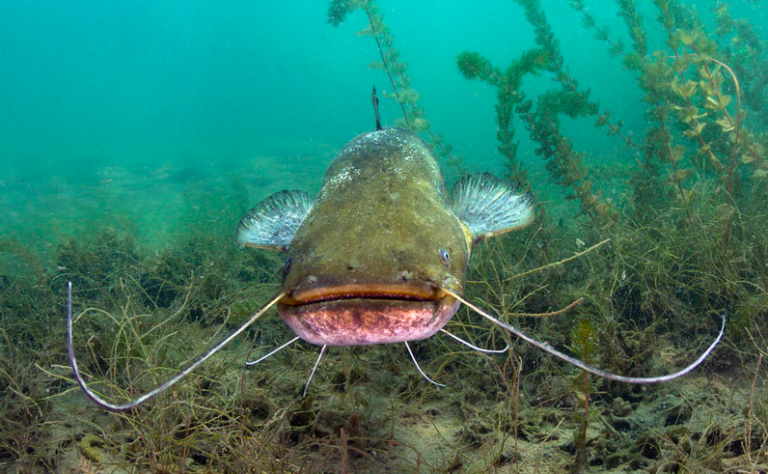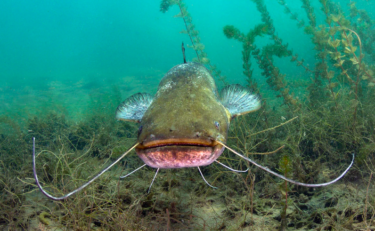はじめに
今日は東京大学の総合図書館に来ている。興味深い図書も多い。「ウクライナに抑留された日本人」などウクライナ関連の図書などもある。親日国家であるウクライナについても別途投稿したけど、今日もまずは英語のトピックに取り組みたい。今回選んだのは、「The fish that walk on land – Noah R. Bressman」だ。生物は海で産まれが、なぜそれが陸上で生きることを選択したのだろう。環境の変化による必然的な進化だったのだろうか。動画を見ながら少し考えてみたい。興味のある方はぜひ視聴して欲しい。
(出典:YouTube)
陸上を歩く魚たち
TED動画の中でいくつかの陸を歩く魚が紹介される。
ウォーキングキャットフィッシュ
まずは最初は歩くナマズだ。英語名はそのままで「ウォーキングキャットフィッシュ」だ。東南アジア原産でたいわん、フィリピン、日本にも移入分布している。全長が55cmほどで沼や河川に生息する。空気呼吸ができるので、地上を這って移動する。両鰭をうまく使って赤ちゃんのハイハイのように移動する。陸上の昆虫なども捕食する。
アーマードナマズ
同じナマズ科でもカリクティス科 (Callichthyidae) のアーマードナマズ(Armored catfish)は、対側に強い棘がある。口は腹側にある。このアーマーずナマズは、飲み込んだ空気を胃の粘膜で吸収することで酸素を体内に取り込む珍しい仕組みだ。魚の皮膚は一般に薄く浸透性があるため、陸上では体内の水分が空気中に拡散して脱水するので、これを防ぐために泥の中を転げ回ったり、粘液状のもので体を保護している。乾期になると土の中に潜って、粘液をまゆのようにして体を保護して何年も生き延び、次の大雨の時に蘇生するという。
ノボリハゼ
ハワイには、高さ数百mの滝を登るノボリハゼがいる。ハゼの一種でノピリ・ロッククライミング・ゴビー(Nopili rock-climbing goby)は、口と骨盤のヒレにある吸盤を交互に使って、滝を登っていく。体長はわずか2.5センチほどだけど、数十メートルの滝を登るのは凄まじい運動量だろう。

(出典:National GeoGraphic)
海進と海退が原因か
魚の生息地は本来は水中だ。生命が生まれたとされる海で産まれ、育った魚のの一部は川を遡り、淡水でも生きるようになり、沼や池でも生息するようになった。しかし、なぜ、水中から陸上に移動したのかが不思議だ。個人的には、陸上の移動したのではなく、水中が陸地に変わり、陸地が水中に代わり、そのような外部環境の変化に追随した生物が生き残ったのでないかと想定している。特に地球はほぼ10万年周期で温暖化と寒冷化を繰り返していると以前も投稿した。そして、温暖化の時期には海面が上昇するという海進が進み、寒冷化の時期には海面が下降するという海退が進む。海進と海退を繰り返すことはすなわち水中が陸になり、陸が水中になる。そんな地球上で生命が生き延びてきた歴史を考えると、象の鼻が長いのも、麒麟の首が長いのも、人間に2足歩行に移行したのも、これら外部環境の影響を少なからず受けているのではないだろうか。
8つの質問
動画を視聴すると、TED-Edでは8つの質問に答える画面に映る。
Q1) Armored catfish breathe air using their
最初の質問は、前述のとおりアーマードナマズはどのようにして空中の酸素を吸収するのか?という質問で、答えは「stomach」となる。
Q2) Which of these are not a challenge that fish face out of the water?
魚が水から出ると幾多の苦難に挑戦することになるが、関係ないのは何か?という質問で、浮力の調整は関係ないので、「Maintaining buoyancy」となる。
Q3) Mudskippers stay moist out of water by
マッドスキッパーはどのようにして湿度を維持するかという質問で泥の中を進むことで泥で水分の蒸発を抑制しているため、答えは「Rolling around in the mud」だ。
Q4) Which sense do fish use to orient out of the water?
魚が水から出たときにどのようにして方向性を使うかという質問だ。後半で、モスキートフィッシュは、水に続く坂道を降りるために内耳(inner ear)を活用して自分の向きを判断する。歩くナマズは体を覆う味蕾(taste bunds)とヒゲを使って獲物の近さや水の質を感知しているので、「Vision」「Taste」「Balance」の全てを使っているのが回答だ。
Q5) Which is not a reason for emersion?
エマージョン(emersion)の理由でないものはどれかという設問だった。エマージョンの意味が難解だけど、陸に上がることを指していると理解すると、選択肢の「High air pressure」だけは関係ないので、これが答えだろう。
Q6) Fish face many challenges out of water, some of which were discussed in this lesson, such as drying up, respiration, and new predators. What are other challenges that fish may face out of water?
魚は水中で生きるのものであり、水から出ルコとは様々な困難に直面する。乾燥、呼吸、新しい捕食者の他にどのような課題があるかという設問なので、他には悪天候時の強風、嵐時の波浪、洪水などに直面する可能性がある。英語なら次のような感じだろうか。
Q7) Most fish spend their entire lives in water, but even amphibious fish need water from time to time. Why do amphibious fish need water?
魚は水中で生活するが、陸に上がった魚も時々水が必要になる。それはなぜかという質問だった。ここでは酸素を吸収するためとしたけど、他にも皮膚の感想を防ぐためなどもありそうだ。
Q8) Climate change is making floods and droughts more severe and frequent around the world. How might this affect amphibious fishes? Is amphibiousness an advantage or disadvantage in these circumstances?
気候変動で世界中で洪水や干ばつが頻発する。これは水陸両用魚類にどのような影響があるか?また、それは有利か不利かという説もんだ。前述の通り環境の変化に適応して生き残ったのが現在の生物と言える。なので、有利であるが、単なる自然だけではなく人工的な環境変化も加わっているため、今後100年で両生類は全て絶滅するという予測もあるぐらいだ。ここでは、そこまでの回答ではなく、単に干ばつになると土に埋まり、粘液のまゆで体を保護して、次の洪水を待つという仕組みについて記載した。これだとちょっと点数は低いかなあ
まとめ
生物関連の英語の聞き取りは、そもそもの知識が不足していること、用語に不慣れなこともあり、結構難しい。ただ、TOEFLでは生物や環境、自然などの理科系はよく出るし、慣れておく必要がある。また、そもそも面白い。
以上
最後まで読んで頂きありがとうございました。
拝
参考:英文スクリプト
This pond is the only home this fish has ever know. But lately, it’s gotten crowded and food is scarce. Luckili, it has an option many don’t: as a walking catfish(ナマズ), it can dance its way out of the water and onto bigger and better things. However, it faces many challenges on its terrestrial journey: It’s now in danger of suffocating(窒息), drying up, suffering physical damage from tough terrain, and being hunted by land predators.
We think of fish as completely aquatic animals. But the walking catfish is just one of hundreds of fish species that are actually amphibious(水陸両用), meaning that they possess adaptations that enable them to survive on land. Fish amphibiousness is a spectrum. At one end are species like the mosquitofish that’ll only move on land when forced. And at the other end are species like mudskippers that nonchalantly hop around mudflats for days at a time.But why do fish make the exodus from water to land? And how do they cope with this drastic transition? If temperatures get too high for the mangrove rivals in the shallow tropical pools it inhabits, it’ll flip itself onto a bank and cool off in the shade. During the dry period, it can survive for two months out of the water by staying in moist environments. Meanwhile, the eel catfish makes its onshore voyage to satisfy its hearty craving for beetles. And for others, the terrestrial(陸上での) draw is more ritualistic(儀式的). Every year under the cover of night, masses of California grunion flop their way onto sandy beaches, where females deposit thousands of eggs into the sand before re-entering the ocean.
Underwater, fish breath with gills(エラ), which are feathery organs packed with blood vessels that absorb dissolved oxygen(酸素) from the water. But in the open air, their gills collapse and are rendered useless, so amphibious fishes need other ways to breathe. The armored catfish’s stomach is packed with blood vessels, so it gulp down air and breathe though its stomach lining. And lungfish(肺魚), being related to the ancestors of all tetrapods(四肢動物), or four-limbed vertebrates, are equipped with true lungs. They’ll actually drown if they are kept underwater too long. Fish have thin, permeable skin that allows for essential compounds to diffuse into and out of their bodies while they are underwater. But this works against them on land as their bodily moisture diffuses into the air. To dodge dehydration(脱水症状), mudskippers(ムツゴロウ) roll in the mud like puppies. But the lungfish takes the cake: the revers it inhabits disappear during dry seasons, so it buries itself in the earth and coats its body in a mucous cocoon(粘液のまゆ). It can survive like this for years until being resuscitated by the next big rainstorm. Amphibious fishes use powerful fins to move on land and clever tools to navigate as they go.
The Nopoli rock-climbing goby(ハゼ), no bigger than a few centimeters, scales hundred-meter-tall Hawaiian waterfalls, inching its way up by alternately attaching the suction cups on its mouth and pelvic fins. To find water while on land, the mummichog, like most amphibious fishes, is on the lookout for reflective surfaces. Other species, like mosquitofish, exercise their inner ear to determine where they are oriented on a slope, relying on the probability that they will find water by moving downhill. Our walking catfish, meanwhile, uses the taste bunds(味蕾) that coat its body for navigation. These taste buds are concentrated in its whiskers(ヒゲ), which whip through the air, sensing compounds that signal the proximity and quality of nearby water- and prey. The walking catfish will shimmy towards attractive volatile amino acids(揮発性アミノ酸) while steering clear of foul waters emanating hydrogen sulfide. While amphibious fishes face a multitude of new challenges upon leaving the water, they have evolved ingenious ways to overcome them. They are resilient in the face of droughts and floods and have access to new prey as well as a plan B if they need to escape competitive, polluted, or unhealthy environments. While being a “fish out of water” is generally regarded as a bad thing, for these species, it offers an undisputed edge.




